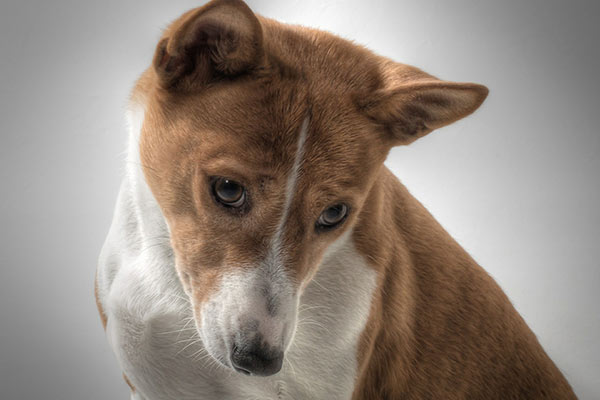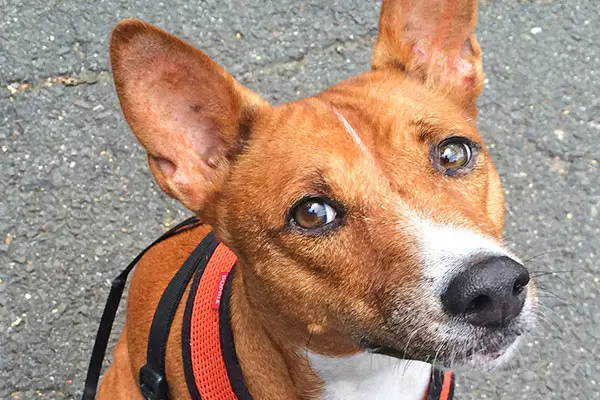Basenjis are known to be one of the smallest hounds that only stands at a maximum height of 17 inches. The Basenji has a glistening coat that comes in colors of red, black, black and tan, or brindle. Their foreheads are wrinkled, and their eyes are expressive that you may even think they’re humans on a dog’s body.
These dogs are beautiful, but they are not dogs for first-time dog owners. They require a lot of work, and they can be challenging to raise too. However, for people who have longer patience, these dogs will make excellent companions for play.
Basenji Breed Statistics
| Dog Breed Group | Hound |
| Breed Size | Medium |
| Height | 17 inches (male); 16 inches (female) |
| Weight | 24 pounds (male); 22 pounds (female) |
| Lifespan | 13-14 years |
Basenji Breed Ratings
| Energy level | |
| Exercise needs | |
| Requires attention | |
| Playfulness | |
| Trainability | |
| Shedding | |
| Grooming | |
| Friendly with family | |
| Friendly with kids | |
| Friendly with strangers | |
| Friendly with other dogs | |
| Prey Drive |
Basenji History
Basenji is an ancient dog breed whose history can be traced back to Africa. The ancestors of the Basenjis are believed to be prized hunters of African Tribesmen, known to have keen eyesight, impressive speed, and a great sense of smell.
Later, these dogs were brought up to the Nile as gifts to Pharaohs, where they became great companion dogs. This is what made them well-known to be one of the oldest domesticated dog breeds.
The breed was kept isolated for thousands of years until the 1800s when several Westerners finally discovered them. The first attempt to import the breed happened in 1895, but the Basenjis died.
It took several years after that before a new pair was imported in 1937. Because it was a new breed, this caught the curiosity of several British people. However, the litter of puppies and the female Basenji died, leaving only the male Basenji.
A Boston breeder then decided to race the male Basenji named Bois. He later soon acquired a female Basenji named Congo. This pair is what’s responsible for creating the first breeds of Basenji in America.
Not long after, as the breed number grew, the Basenji Club of America was formed in 1942. And by the year 1943, the American Kennel Club finally recognized the breed. Now, they rank 87th as the most popular dog breed in the US.

Basenji Temperament
The American Kennel Club describes the Basenjis as independent, smart, and poised dogs. They have high energies and spirits and will get bored if not entertained much. These dogs need lots of physical and mental activities and should not be left unsupervised.
As one of the oldest domestic dog breeds, Basenjis are excellent family dogs. They are affectionate dogs to their owners. They are also known to be good with other dogs and children who were raised with them.
Not so outgoing with strangers, the Basenji is an alert dog and will make excellent guard dogs. They also have tendencies to chasing little animals such as cats, squirrels, and rabbits.
Socialize them at an early age, so they get used to new sights, sounds, people, and animals. This also helps in making them more well-rounded dogs.
Training should be provided with consistency and kindness. Always use positive reinforcements such as rewards and praises to make them obey. Never treat them harshly, even if they are stubborn dogs.
Basenji Care Requirements
- Nutrition: Basenjis don’t have special feeding requirements. All they need is a high-quality and well-balanced diet that will help support their high energy needs. Just make sure not to overfeed them as they can quickly get overweight. Home-cooked meals are highly recommended for these dogs as you’re preparing the food yourself. Make sure to buy only high-quality ingredients for them. Animal meat, chicken and fish oils, whole grains, fruits, and vegetables are excellent sources of protein, fats, carbohydrates, and vitamins. For dog food, you can buy premium quality ones because these don’t contain fillers and additives that can be harmful to your dogs.
- Grooming: Basenjis are very low maintenance dogs that require very minimal grooming. They have short breeds that shed occasionally, and a quick once-over of a brush should suffice to make their coat look healthy. You might need to brush more frequently during the shedding season, but it wouldn’t take much of your time. Baths can occasionally be given too, as these dogs don’t have that doggy odor. However, make sure that you regularly clean their ears to prevent ear infection. Nails should be trimmed regularly to avoid pain and discomfort to your dogs walking and running activities.
- Exercise: Basenjis are highly active breeds that need lots of physical and mental activities. The more tired a Basenji is, the less destructive it can be. Daily walks should suffice for this dog breed. However, play sessions with their humans will make them happier. Keep them on a leash if you don’t have a secured fence. They’re curious dogs, and this may cause them to wander around or chase if you don’t keep them secured. If you’re feeling a little extra, you can have him participate in canine sports to showcase his skills in tracking, obedience, and agility.
- Health: Basenjis are generally healthy dog breeds with long lifespans. But as a dog owner, it’s also best to know what diseases your dogs are prone to. Fanconi Syndrome, Immunoproliferative Systemic Intestinal Disease, Pyruvate Kinase Deficiency, Hypothyroidism, Persistent Pupillary Membrane, Coloboma, Progressive Retinal Atrophy, Umbilical Hernia, and Hip Dysplasia are among the most common health conditions known to come to these dogs. Meeting one of their parents will help in knowing which diseases might be present on your dog’s genes. Screening tests will also help in identifying some diseases in their early stages.
- Lifespan: The life expectancy of Basenjis is 13-14 years.
Famous Basenjis
- Bois and Congo: The Basenji pair who started the whole Basenji breed in the US
Fun Facts about Basenjis
- Basenji dogs are believed to have originated from Africa centuries ago.
- Egyptian evidence suggests that they were developed around 4000 BC.
- They are gifts by Africans to Egyptian Pharaohs.
- These dogs are used to lure lions out of their caves in Kenya.
- It took a few tries to bring them to Europe and create more puppy litter.
- The Basenji dogs don’t bark.
Check Out Other Hound Dog Breeds:
Afghan Hound, American English Coonhounds, American Foxhound, Basset Hound, Beagle, Black and Tan Coonhound, Bloodhound, Bluetick Coonhound, Borzois, Cirnechi dell’Etna, Dachshund, English Foxhound, Grand Basset Griffon Vendeens, Greyhound, Harrier, Ibizan Hound, Icelandic Sheepdogs, Irish Wolfhound, Norwegian Elkhound, Otterhound, Petit Basset Griffon Vendéen, Pharaoh Hounds, Plotts, Portuguese Podengo, Redbone Coonhound, Rhodesian Ridgeback, Salukis, Scottish Deerhounds, Sloughis, Treeing Walker Coonhound, Whippet


